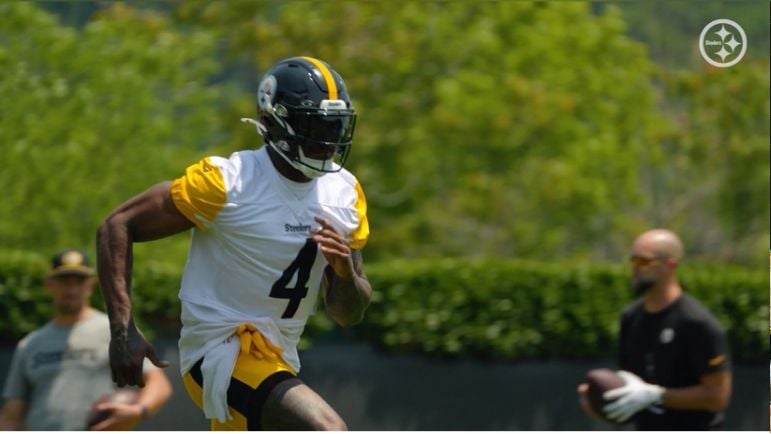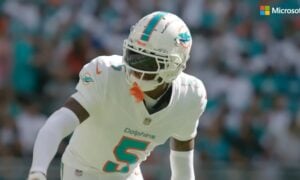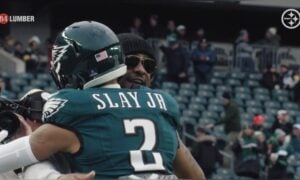The Pittsburgh Steelers have made their big moves for the 2025 offseason—probably, at least. With training camp coming up, which flips the switch from offseason to preseason and, soon enough, regular-season action, it’s worth reviewing the Steelers’ most notable moves from an unusually busy past few months. Any move will ultimately be judged by what happens during the season. Everything until then, including my thoughts, is just speculation.
But to wrap a bow on things, here are my offseason grades on the Steelers’ weightiest moves in order of when each occurred.
Trading For DK Metcalf (Grade: A+)
Pittsburgh came out of the gate by landing Metcalf the day before the legal tampering period of free agency started. In search of the ideal Arthur Smith receiver, big, physical, and a fierce blocker, Metcalf checked all the boxes. In compensation and contract, the cost wasn’t cheap. Pittsburgh sent the Seattle Seahawks a second-round pick and paid Metcalf $150 million, the most money ever paid to an outside addition.
But the Steelers didn’t overpay, either. A second-round pick for someone of Metcalf’s talents, especially in a poor 2025 WR draft class, was a shrewd move.
Metcalf won’t produce mega-volume like other No. 1 receivers, and quarterback play has an obvious role in the level of his success. But he’s here for the long haul, and Pittsburgh will hopefully find a franchise quarterback at some point along the way. This was a perfect, aggressive move to begin jump-starting the offense. Especially assuming the team knew George Pickens wasn’t making it through the summer.
Drafting DL Derrick Harmon (Grade: A)
Shutting down endless speculation over selecting a first-round quarterback, Pittsburgh went tried and true by beefing up its front seven in the draft. I respect the overall approach of GM Omar Khan using his three drafts to intensely focus on the offensive and defensive lines. No doubt, assistant GM Andy Weidl is an influencing factor.
Harmon was the ideal pick. A great scheme fit, he played in a similar system at Oregon, which will lessen his NFL learning curve. He’s youthful but productive, breaking out in 2024 with the Ducks. Defensive line was a serious need that wasn’t significantly addressed in free agency, making the draft the Steelers’ only chance to make a big swing. The board broke well with Harmon falling to them.
He’s poised to start out of the gate and play serious snaps as a rookie. There’s some injury risk, a one-year resume of stats, and some areas of his game to work on. But I like the approach and the prospect, and that’s the goal of exiting the first round feeling like it’s a win.
Trading WR George Pickens (Grade: C)
Sorry, they can’t all be A grades. It’s no secret why Pickens was traded. Pittsburgh was done with him and had no intentions of extending him off his rookie contract. Instead of letting him hit free agency and play the comp-pick game, the Steelers made the move in May to deal Pickens to the Dallas Cowboys for a 2026 third-round selection.
While the reasons are understandable, they don’t solve the problem of replacing him. Having Pickens and Metcalf in a lineup, even for a season, was enticing. And as the Steelers made moves to win now, even at the risk of adding big personalities like QB Aaron Rodgers and CB Jalen Ramsey, Pickens was shown the door. It’s inconsistent messaging.
The Jonnu Smith addition shows how tight end-heavy Pittsburgh will be. Still, he doesn’t replace the outside/vertical plays that Pickens so effortlessly made, which could’ve had a domino effect on the offense. More two-high shells mean more plays down the middle and lighter boxes to run the ball. It also means fewer blitzes that leave cornerbacks on islands. With Pickens gone, Pittsburgh loses those benefits.
The value of the deal was fine, and a third-rounder was his expected return, though it comes in 2026 instead of 2025. It’s impossible to say how much of a market Pittsburgh had for Pickens, but making the deal post-draft made it harder to replace him. The Steelers will say they had to wait for Dallas to make its top offer. I’ll say it doesn’t solve the problem of making the offense the best it can be this season. If the offense feels a piece short for another season, the Pickens trade won’t be viewed as favorably.
Overall, it was an acceptable deal—not terrible, not great. It was fine, and it earns a grade that reflects that.
Signing QB Aaron Rodgers (Grade: B-)
I’ll admit I’ve warmed up to the Rodgers addition. At least a little. He still wasn’t my first or second choice, and it sounds like the team thought the same. But of the options remaining once Justin Fields left for New York, Rodgers became the best available one. With the right talent and scheme around him, he can still play and thrive from the pocket.
It took three annoying months for Rodgers to decide and sign, but he seems genuinely rejuvenated by joining Pittsburgh. He’ll be a good mentor to a young quarterback like Will Howard, and even if it doesn’t work out, there’s little invested in him. Rodgers signed for cheap, and his addition didn’t prevent Pittsburgh from making any other offseason moves.
Rodgers does nothing to address Pittsburgh’s long-term quarterback issue, and it’s frustrating to know the Steelers will spend the 2026 offseason searching for a quarterback. Again, a lack of continuity at the position doesn’t breed success. Virtually no Super Bowl-contending team consistently churns through quarterbacks like the Steelers have. Hopefully, 2026 stops that search. Until then, Rodgers will be a good bridge in a year that will be interesting no matter what.
Minkah Fitzpatrick, Jalen Ramsey/Jonnu Smith Trade (Grade: C+)
I’m more skeptical of the deal than most and understand many fans would give this an A. I’m just staying consistent. My evaluation of Fitzpatrick a year ago was that he had a down year by his standards and wasn’t the same player as he was in 2019-2022. The Steelers’ scheme isn’t even to blame. Fitzpatrick just didn’t play up to par.
But I felt confident Fitzpatrick would bounce back and return to form in 2025. I bet on stars to do that, just in the way I did with DL Cam Heyward a season ago. Sometimes, the difference between an interception and not is slim. Fitzpatrick also brought plenty of value as a tackler, run defender, defensive leader, and threat that quarterbacks were still careful throwing around.
That said, Ramsey and Smith have their place. Ramsey is an alpha corner who fits the offseason mantra of adding physical playmakers on both sides of the ball. Smith is a great fit in an offense that’s proven to use him effectively, holding a long history with OC Arthur Smith. It’s two starters for the price of one.
Still, Ramsey and Smith are older than Fitzpatrick, and their decline could start at any time. Ramsey isn’t the elite corner he once was, either, and he seemingly can’t call any place home for more than short stints. Pittsburgh’s also shaken up the secondary and seems intent on adding defensive complexity to a new-look group. That could strain communication, a critical issue last season.
Overall, the thought I can’t escape is this: Because of his contract and Miami’s lack of leverage, Ramsey was viewed as someone who could be fetched for a Day 3 pick. Smith was definitely available for a Day 3 pick as a near-30-year-old tight end wanting a good-money extension. How does that turn into a starter like Minkah Fitzpatrick? It’s a tough pill to swallow.
There are cash and cap considerations in this, but I haven’t seen any math that says Pittsburgh, not spending lavishly at quarterback and able to restructure multiple contracts, had to trade Fitzpatrick to make the trade work. Instead, the Steelers preferred to hold onto their 2026 draft picks. Now, they’ll need to make the pieces fit while replacing a defensive pillar like Fitzpatrick.
Share your grades – and disagreements – below. I know you have plenty of both.








